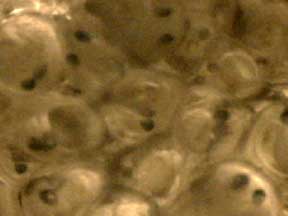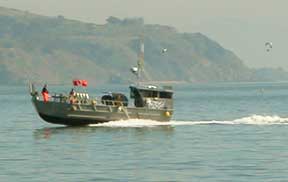 |
Every year, in October or November, the herring boats come down from the North on 18 wheel trucks to San Francisco Bay. They come from ports like Juneau AK and Bellingham WA, and many end up in Sausalito. For their 40 feet they are a sturdy boat, usually made of aluminum, powered by two inboard-outboard diesels, and capable of carrying several tons of fish. A gill net is played out over rollers at the bow and the boat anchors for several hours or over night, and then pulls the net back in, shaking the fish out of the net and into the hold. It's then only a few minutes back to the Fish Dock where the herring are sucked out of the boat with a giant vacuum pump.
|
|
|
|
The Pacific Herring, Clupea harengus, is found from Baja off Mexico to the Bering Sea off Alaska. They come into bays and estuaries to lay their eggs. For fish caught here only the herring roe has commercial value, mostly in Japan. The harvest of herring, if it is to be sustainable year after year, needs to be a balance between allowing some fish to lay and fertilize eggs to catching adults and selling the roe.
The California Fish and Game Department sets a limit on the total number of tons that can be caught. After several disappointing seasons the fishery seemed to be rebounding (but see the hard economics of the fishermen). However, this year, 2004-5, herring arrived late and in low numbers. I decided that if I was going to study the development of herring I better start now, before it's too late.
Eggs -> Fish -> Eggs -> Fish... ---- It's a cycle; let's arbitrarly start with an egg.
|
|
|
|
The eggs are laid on eel grass growing on the bottom of the Bay or on sea weed and rock surfaces along the shore. The first significant run was on the 20th of January. You can't easily see the fish but when dozens of boats and thousands of sea gulls suddenly appear it's very obvious that the herring have arrived. I collected eggs from the rocks along the center of Sausalito just a few dozen yards from some of the nets.
There seemed to be just a single school of fish, for the next day both the sea gulls and boats were gone. The rocks were covered with eggs, I could get all I needed on one little leaf of sea weed.
|
|
 |
|
|
|
|
|
|
|
|
|
|
|
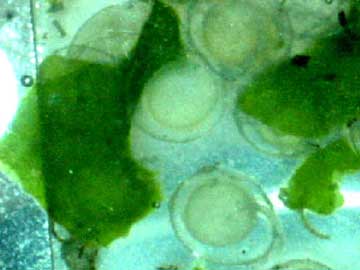 |
|
This is a low power view of a few eggs collected a day after the herring run. In order follow the early development of the embryo you would need to know the precise time of fertilization, because that's when it starts. This could only be done in a laboratory setting where eggs and sperm were added at a known time. In our case the times are somewhat vague, but probably within a day.
The full width of the image is 5 mm, so the eggs are about 1.3 mm in diameter. Like a chicken egg there is a shell which protects against dehydration; remember that these eggs are out of the water when the tide is low. The middle of the egg is filled with yolk, which "feeds" the embryo as it develops. In between the yolk and shell is a layer of albumin (the white of a chicken egg). The embryo grown on the outer surface of the yolk.
At this magnification you can't see an embryo; let's increase the magnification 5 fold and illuminate the eggs from below.
|
|
|
| < image 5 mm (1/5 th inch) width in real space > |
|
|
At this magnification we see a crescent shaped body draped around the upper half of the yolk. At day 2 the embryo has only grown for one or two days out of (as we will see) the total time of ten required to hatch. However, the cells have been dividing every one or two hours; ten divisions gives 1,000 cells and twenty divisions gives 1,000,000 cells. In fact many of the most interesting stages have already occurred. The cells have formed a layer and then curled over to form a tube that will grow into the spinal cord.
Observing earlier stages, at least for these eggs, requires techniques and instrumentation (phase contrast) beyond my means, at least until I win the MacArthur "genius" prize.
|
|
|
|
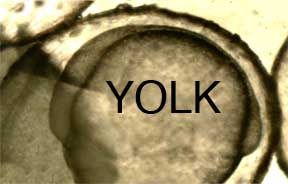 |
|
|
|
|
|
|
|
|
|
|
| Three days later, and at the higher magnification (1 mm full width). The two eyes are clearly at the bottom, but the rest of the interior of the egg looks like it is filled with a coiled snake (the muscle somites look like the scales of a snake, don't they). Even if you look at many eggs in different orientations it's still quite confusing. However, some of the eggs are hatching and then it's clear what is inside the egg. |
|
|
|
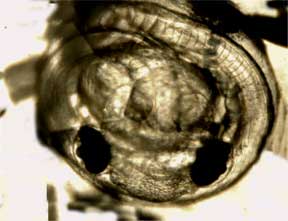 |
|
|
 |
|
|
| This is a newly hatched herring! It's at the lower magnification, 5 mm full width, so the fish is about 5mm long. No wonder that the embryo in the egg looked coiled, it certainly was. |
|
|
|
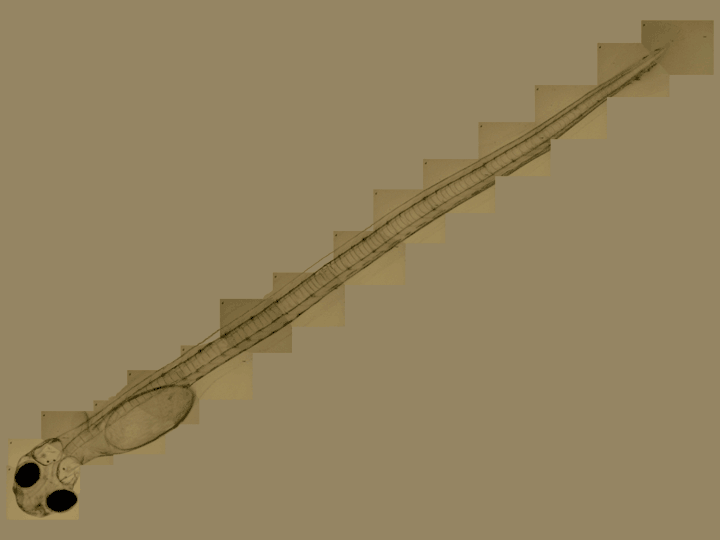 |
|
| This is a mosaic of 16 images captured at the higher magnification. The "stomach" is really the remaining yolk sac. The fish can swim well, and for a few days it can still live on the yolk. But soon it will have to eat real food to live and grow to an adult. A nice crunchy copepod would just hit the spot right now. |
|
|
|
more information on development
|
|
|
|
 |
|
|
The little herring will take 4-8 years to grow to an adult large enough to harvest, like the one on the right, which is about 20 cm (8 inches) long. Like salmon, adult herring return to the area in which they have hatched to spawn, but unlike salmon a female herring lays eggs for several years. Each female lays about 50,000 eggs, so the average hatchling must not have a very good chance of growing to be an adult or the oceans would be overrun with herring.
In Europe herring are widely eaten; they are essentially a big sardine. In the US they are used for fish bait, cat food or fertilizer. Herring is a favorite food of salmon, so it's not surprising that herring are a favorite bait of salmon fishermen.
|
|
|
| Links to more information on herring:
Point Reyes Light
2005: Herring of to a bad start: info on this years season
Review of book on SF Bay
2003: general info on herring fishery
UC Berkeley paper
general info on eggs and reproduction; many references
SF Chronicle
2000: general info, start of decline in fishery
General info
concentrates on Washington State fishery
UC Berkeley
herring communicate by farting (breaking wind)
British Columbia
herring for bait
|
|
|
|
|
|
|
|
|
|
|
|
|
|
|
|
|






